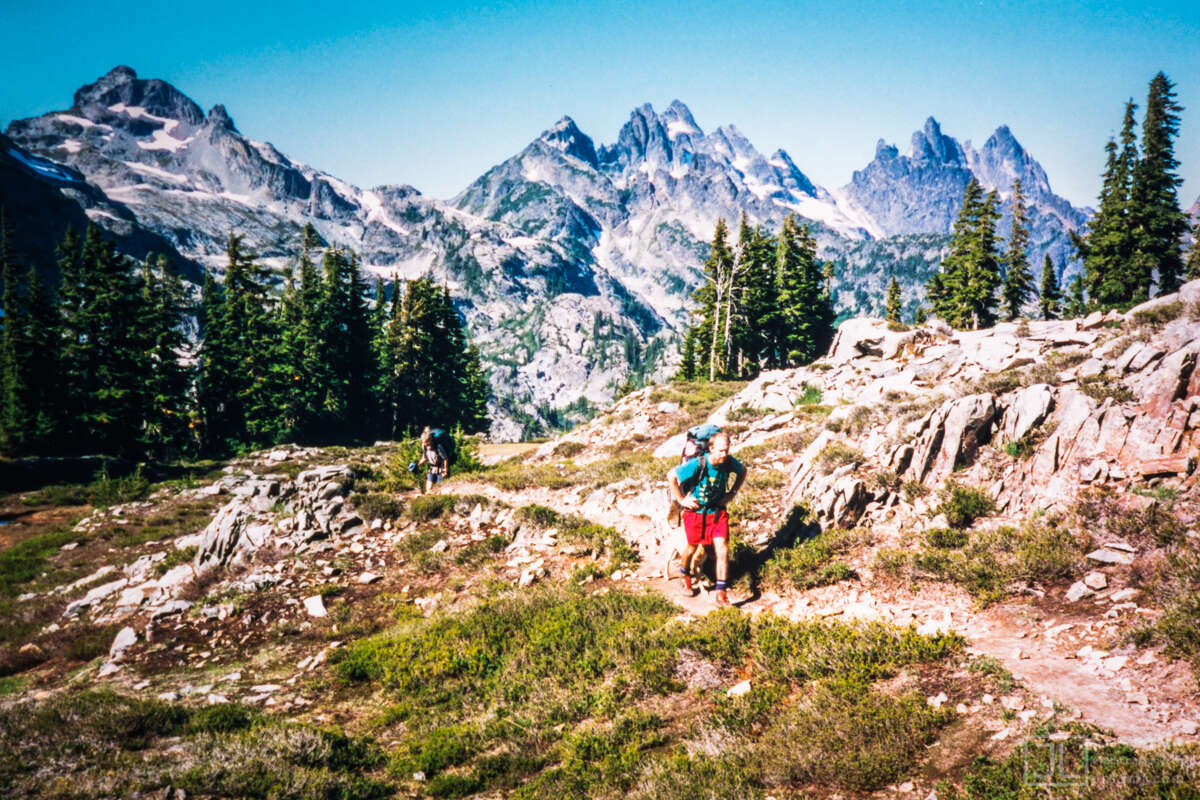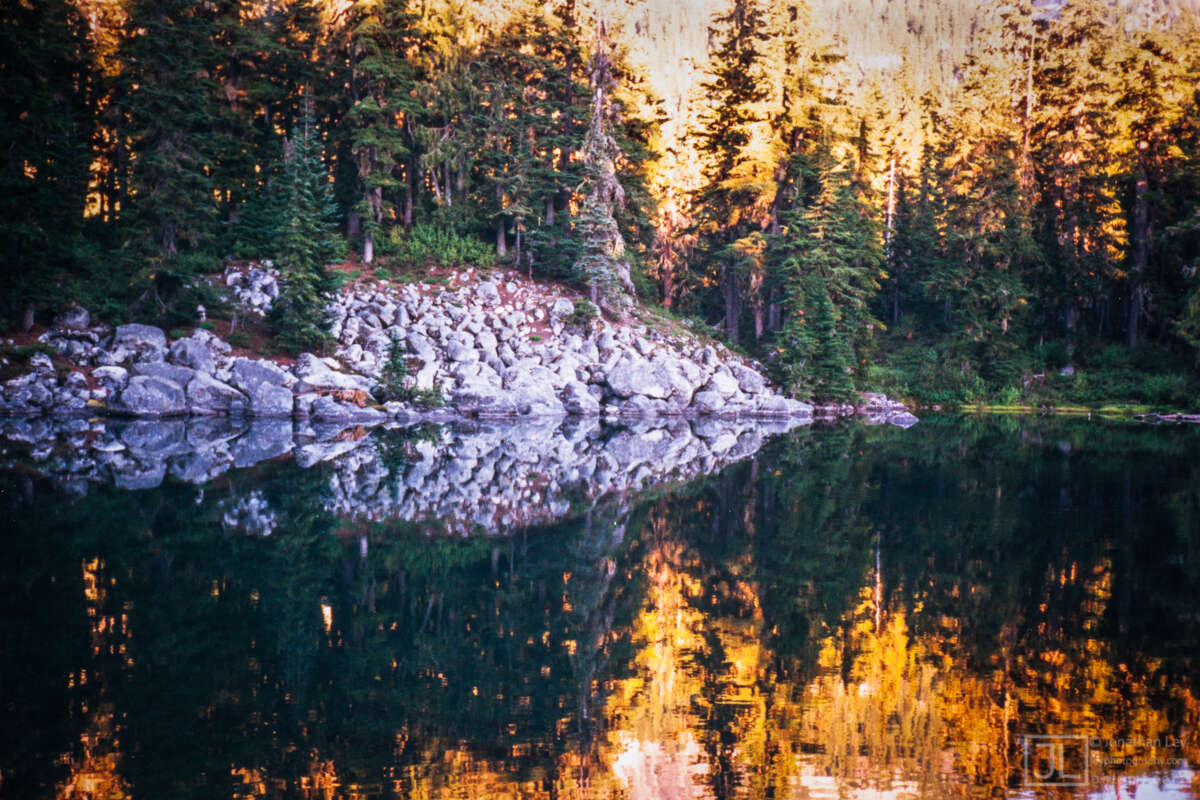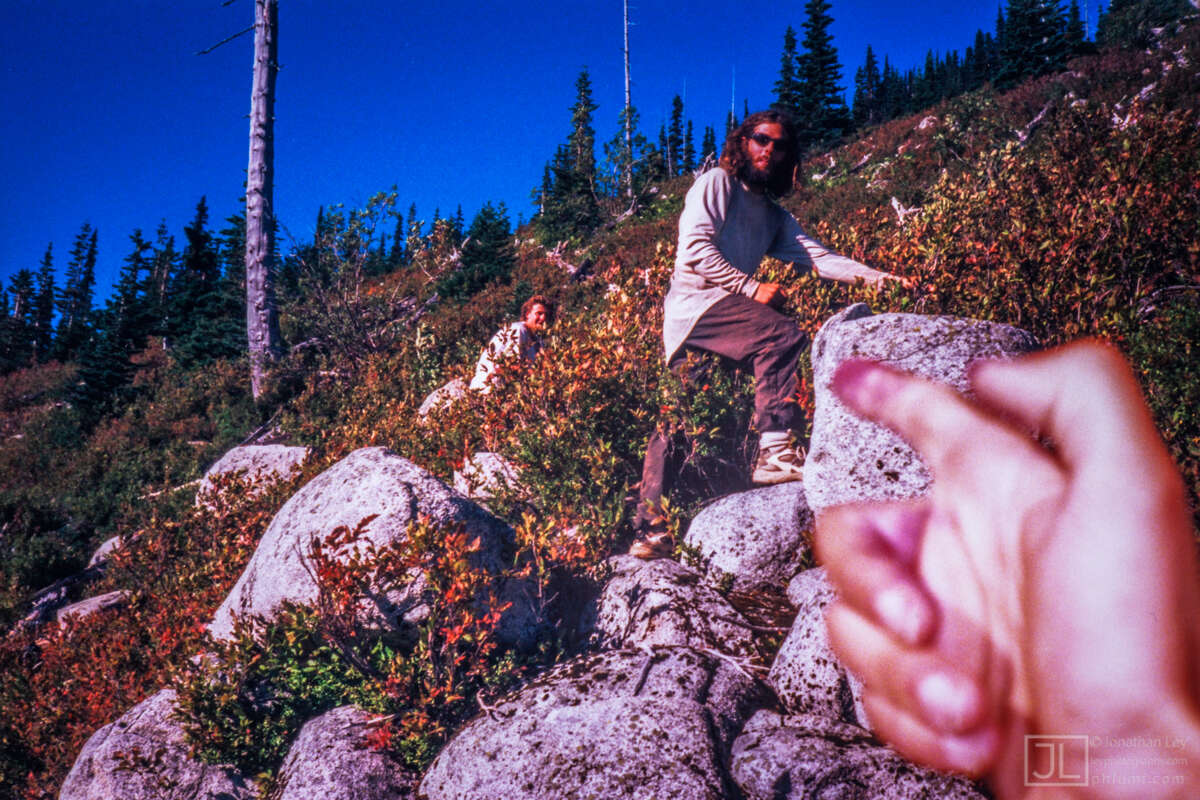For the first time in over 2000 miles, I was in somewhat familiar territory. I had hiked the start of section J twice before. Those had felt like fairly long hikes… even though I’d only gone 6 miles out at most. That distance seemed like nothing now. I started to worry that hiking the PCT would destroy my ability to fully enjoy short hikes. Well… maybe it would just change them. In any case, it was nice to be hiking with some “pre-PCT” friends.
The three of us (well, 4 counting the dog) headed up the trail. North of I-90, the mountains abruptly got more interesting. We were entering the Alpine Lakes wilderness area, one of the most popular wilderness areas in the state.
The trail quickly ascended the south side of Kendall Ridge. We walked across an area called the “katwalk” – a rocky trail blasted out of a cliff side – and had views back to the barren north side of Kendall Ridge. A year or so earlier I had hiked this section of trail and thought, ‘if the rest of the trail is this cool, I have to hike the rest of it’. Well, now I was in the position to say that most of the trail was indeed this cool. But it was all completely different. It was never routine.
We didn’t get too far that day, and camped above the trail in a flat open brushy area. The mountains slowly got dark. It was a quiet peaceful night.
We woke up to a perfect clear morning. A tiny bit of dew decorated everything close to the ground. As the sun came up and warmed the air, tiny flies began circling endlessly around our heads. I sat there in my sleeping bag, killing flies non-stop. It didn’t matter, there was an endless supply. At least they weren’t biting, they were just bugs…flying into our mouth and eyes, trying to make the most of the little summer they had left. The only way to get out of the flies was to start hiking.
After about 2 minutes, I left “familiar territory” and headed up miles of trail I’d previously only looked at. The trail continued its traverse around the sides of the mountains. We were completely out in the open and had mountainous views in every direction we looked. To the south, Mt. Rainier was still massive although now quite distant.
We briefly stopped at a couple lakes populated with weekend backpackers then continued right along our mountainside traverse. Bill kept busy picking out all the mountains in the area, “Hmmm, I don’t think I’ve ever seen Chickamin Peak from this angle…”. He’d obviously spent a lot of time in the mountains of Washington. He wasn’t even sure if he’d hiked this trail before. I suppose they all blend together after a few years. I felt like I was getting a private tour of his vacation home.

After hiking all summer, my perception of “a long day” was somewhat skewed. I was averaging around 25 miles for a full day’s hike. We decided to take a more moderate pace of 12-15 miles a day through the Alpine Lakes. It was a nice change. I had just switched back to the boots I’d worn in the Sierra, and they were breaking-in my feet again. The slower pace helped to stave off some nasty blisters on my heels.
We rounded Chickamin Pass, and a whole new scene opened up. Below us was a multi-tiered valley filled with lakes and forests. Steep rocky cliffs were scattered randomly about. These mountains didn’t have the royal and ancient look that I’d become used-to in the Sierra. They looked fresh, like sculptures in progress. Snow and glaciers rested atop the highest peaks, slowly carving them into shapes yet unknown.
We headed down toward the forests and lakes. There had been so much snow the past winter, that the seasons were delayed. Bright red thimble berries, usually ripe months before, were just coming out. The leaves of the plants had the lively look of mid-summer, not the used-up weathered look of early autumn. In the areas bordering the occasional snowbank, new flowers and grasses were just starting to sprout. I wished them luck, but knew they stood little chance of fulfilling their duty before winter took hold.
The trail entered a forest filled with towering trees and skirted around the bases of the mountains. We were barely able to catch glimpses of their rocky tops, some 4000 feet above. We finally found an old campsite next to a nicely flowing creek, then quickly retreated into our tents to avoid the steady flow of mosquitoes from a nearby wetland.
I had so much to talk about that I really didn’t know how to put it. Everything I’d experienced the entire summer was related to everything else. I couldn’t tell where one story ended and another began. I found it hard to be concise and still make sense. Still, I peppered Liz and Bill with fragmented tales… “Oh, then this other thing happened back near Old Station… that’s somewhere in California, um, near Mt. Shasta…”. I began to feel like Meadow Ed, that funny old man who I’d met on the first day of the trip. He just had so much to say, that it all came out as a blur.

The next morning, we packed up our stuff and headed out (original, eh?). There were some old discarded bits of human manufacture scattered around this campsite – clothing, ropes, outdoor gear. Either someone got into to trouble and had to leave quickly, or they just didn’t care. Bill shook his head and stuffed a bunch of it in his pack. I grabbed a little myself.
Ever the forest custodian, Bill picked up all kinds of junk left on the trail. Some rope, two pair of gloves, old tattered clothing… I had routinely done the same earlier in my trip, but by now I’d started to get a bit lazy. The junk of careless hikers just didn’t affect me the same way anymore. Perhaps I’d been spoiled by seeing so much open space, like the first generations of European-Americans, who considered the land an endless resource. I still appreciated and valued the wilderness, but by the same token, it wasn’t as “special” as it had been before. I had just begun to take it for granted. The consequence of realizing this nascent shift in attitude was that it ended. Know thyself, and thou shalt begin to change. I had never been careless (on purpose) myself, but I started to realize how important it was to be careFUL and responsible (even for others) with regards to “leaving no trace”.
The trail quickly began to switchback up a burned hillside. The mountainous views returned. We passed next to small lakes bordered by nothing but rock and snow. We then continued over a ridge-top and dropped down the other side. The rugged terrain of these mountains didn’t afford us many opportunities for a level traverse. Up and down and up and down became the routine… a routine which continued all the way through the North Cascades.
We finally ended the day a mere 12 miles from where we’d started. Flat areas were in short supply, so we camped right on the trail, above Waptus Lake.
The next day started with still more “up”. We followed Spinola Creek all the way up to the outlet of Deep Lake. The lake sat in a small flat basin below towering Cathedral Rock, 2500 feet above. The high cliffs all around held huge lakes in complete secrecy. The view from below showed only steep steady walls of rock.
Bill and I stopped to feed the mosquitoes and get some water while Liz headed up the trail. Lucci raced up the trail to go find her, then a few minutes later came racing back to check on Bill and I. As soon as he saw that we were OK, he disappeared through the tress to go find Liz again. Back and forth… He was running wind-sprints up and down the trail, making sure we stayed in a “herd”. He’d been doing this for a couple days already. We’d hiked about 40 miles, Lucci had probably run 80. I realized that dogs are just plain different than people.
We finally arrived at the base of Cathedral Rock and said good-bye. Liz and Bill had parked a vehicle at the end of a long dirt road, about 4 miles away. I was briefly alone again. I kept hiking toward Deception Pass, and soon came across a small family heading the other way. Dad was in front, his young daughter and son were lagging. They were supporting huge backpacks and wearing jeans. The son looked particularly beat. They were intending to go all the way to Snoqualmie Pass, but it didn’t look too hopeful. Their hike wasn’t going to get any easier.
I quickly caught up to a couple PCT hikers who’d passed us earlier. Michael and Brian were slowing down more and more as they got closer to Canada. We never formally agreed to “hike together”, but we did anyway for the remainder of the trail.
We wound around the mountains north of Deception Pass, and stopped for dinner at Deception Lakes. The water was still as glass. I kept looking over at the lakes, attempting to get the “perfect” reflective photo. A little while later we treated ourselves to dessert, in the form of a 45-minute long berry picking episode. As evening took its hold on the land, we headed up to Pieper Pass. We slept on the flattest spot around – the trail.

The next morning, after challenging each other to sleep as long as possible, we headed down the trail. Within 20 minutes we passed an elderly couple – the same ones I’d seen before Snoqualmie Pass. They were doing well, enjoying every minute. The husband had fallen back a bit in order to get a good photo of a nearby lake.
The rest of the day was a typical “get to the highway as fast as possible so we can relax” hike. It was only about 12 miles to Stevens Pass. As usual, we passed by more and more day-hikers as we got closer to the highway. It was another sunny, hot day. I was beginning to wonder just how long our good weather fortune would last. I had bought a big umbrella back in Portland. Part of the rationale was that if I did the work to carry it, I wouldn’t need it. So far, this superstitious logic was working.
The trail went directly over the top of the Stevens Pass ski area. Workmen were hanging from the lift-poles, getting ready for a big winter. The sounds of new construction echoed up the hill. They were building a new lodge down at the base of the hill, part of a $15 million renovation project. It’s amazing how much money people can make by selling motorized rides up 1800 feet of snow.
I got to the road first and started working on a ride. Before I even got my bearings, an older gentleman drove by in his pickup truck. “Need a ride to Skykomish?”. Hitchhiking a ride had never been this easy. I couldn’t even call it hitchhiking really. George’s hobby was keeping track of all the PCT hikers that came through town. He had just dropped off a couple, and was excited about the perfect timing of my arrival. He agreed to wait a minute for Michael and Brian.
We had a nice ride down the mountain. George was a knowledgeable and kind man. He’d lived in the area since before he was my age. He was a retired forest service employee. He still spent a lot of his time out in the forest and on the trail. I didn’t talk to him very long, but I got the impression his connection to the forest went beyond love. It seemed more like a feeling of duty and pride, something which defined who he was. I was just happy for the ride. “Uh… thanks a lot!”, I’d run out of sincerely creative ways to thank people. I hoped he understood that I truly appreciated his kindness and help.
We ate dinner at the local hotel / restaurant, and split a room upstairs. While we were eating, a tired couple came in wearing bright yellow clothing. I recognized them from my brief stop up at Stevens Pass. They were riding bikes. As we inevitably discovered, they had ridden all the way from Virginia. Wow! thru-bikers! They had started 2 months ago, and were just about done – Seattle was the “finish”. We talked for quite a while. It was refreshing to hear their tales of “road life”, and how it paralleled our own experiences. By this time, a common topic of discussion among the PCT hikers was “what next?”. Biking across the country sounded fun. We (Michael in particular) got all the practical information we could from them. What kind of bike? What did you bring? How did you plan? How far can you go in a day? etc. It was nice to finally ask all the questions we’d been asked all summer long.
The next morning, it was time to get going again. After a late breakfast, we headed out of the sleepy little town of Skykomish. While we were leaving, we noticed an odd sight. A long freight train was slowly struggling up the hill toward Stevens Pass. Some flashing lights were on the other side of it. An ambulance was stuck on the other side of the tracks. I wondered what kind of drama was playing-out inside.
By this time, I’d perfected my hitchhiking routine, the “happy hiker hat” was a key element. I decided that I looked a lot less threatening with a goofy hat, a big smile, and a bright red backpack. (I was shooting for “adorable”, but I don’t think I quite managed that). I was able to swing a ride for 2 with a couple guys who worked at Stevens Pass. Michael got a ride a few minutes later. Reunited at the trailhead, we took some deep breaths and started walking north.